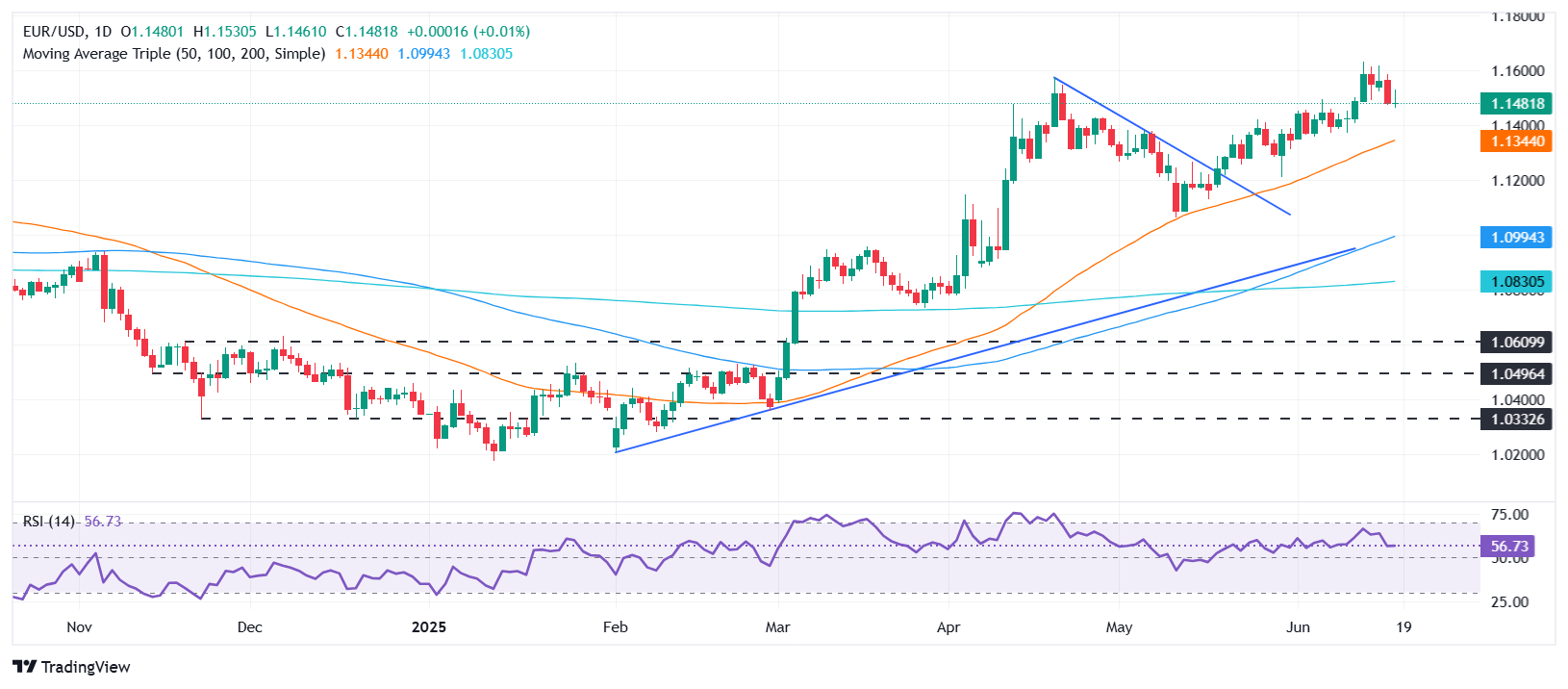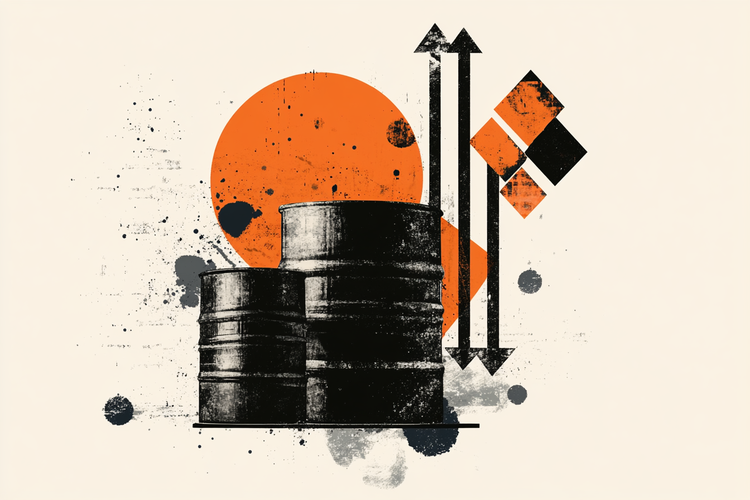- The EUR/USD operates about 1,1476 after briefly exceeding 1,1500 after the Fed.
- The Fed keeps the rates; Projections show more slow growth and more persistent inflation.
- Donald Trump is open to a meeting with Iran, while ECB officials point out the economic weakness of the Eurozone.
The EUR/USD operates almost flat after having exceeded the figure of 1,1500, after the decision of the Federal Reserve (Fed) to keep the rates unchanged, in the midst of growing tensions in the Middle East. This, together with the comments of the US president, Donald Trump, promoted the dollar, limiting the progress of the euro (EUR). At the time of writing, the pair operates in 1,1476, practically unchanged.
Recently, the FED maintained rates in the range of 4.25%–4.50%, reaffirming that the economy is expanding solidly, with strong labor market conditions. The Central Bank of the US reiterated its commitment to monitor the risks associated with both sides of its dual mandate and confirmed plans to further reduce their treasure securities.
In addition, Fed officials updated their economic projections. The Gross Domestic Product (GDP) was reviewed down, the unemployment rate was barely affected and inflation is expected to be slightly higher.
As for monetary policy, those responsible for the policy see two trimmed cuts of interest towards the end of the year.
Apart from this, US President Donald Trump said if Iran wants to come to the White House, he said: “He could do it.”
At the same time, the president of the Fed, Jerome Powell, maintained his slightly neutral position, reaffirming that monetary policy is “well positioned to respond” to external clashes such as tariffs or geopolitical risks.
Previously, the Eurozone (EU) revealed that inflation is maintained within the objective of the European Central Bank (ECB), according to May data. Meanwhile, some ECB speakers, led by Mario Centeno and Fabio Panetta, affirmed that the weakness of the EU economy is a reason for greater concern within the ECB, and over time does not seem compatible with the inflation objective of 2%.
This could pave the way for additional cuts by the ECB, although most officials are in favor of a pause in the Central Bank flexibility cycle.
Euro price this week
The lower table shows the percentage of euro change (EUR) compared to the main currencies this week. The euro was the strongest currency against pound sterling.
| USD | EUR | GBP | JPY | CAD | Aud | NZD | CHF | |
|---|---|---|---|---|---|---|---|---|
| USD | 0.50% | 1.07% | 0.39% | 0.78% | -0.40% | -0.20% | 0.84% | |
| EUR | -0.50% | 0.45% | -0.12% | 0.29% | -0.75% | -0.70% | 0.34% | |
| GBP | -1.07% | -0.45% | -0.55% | -0.16% | -1.21% | -1.13% | -0.10% | |
| JPY | -0.39% | 0.12% | 0.55% | 0.39% | -1.09% | -0.91% | 0.04% | |
| CAD | -0.78% | -0.29% | 0.16% | -0.39% | -1.10% | -0.98% | 0.06% | |
| Aud | 0.40% | 0.75% | 1.21% | 1.09% | 1.10% | 0.08% | 1.13% | |
| NZD | 0.20% | 0.70% | 1.13% | 0.91% | 0.98% | -0.08% | 1.05% | |
| CHF | -0.84% | -0.34% | 0.10% | -0.04% | -0.06% | -1.13% | -1.05% |
The heat map shows the percentage changes of the main currencies. The base currency is selected from the left column, while the contribution currency is selected in the upper row. For example, if you choose the euro of the left column and move along the horizontal line to the US dollar, the percentage change shown in the box will represent the EUR (base)/USD (quotation).
What moves the market today: the EUR/USD falls while the Fed seems ready for two rate cuts
- The EUR/USD extended its losses as Trump opens the door to conversations with Iran, while the president of the Fed, Jerome Powell, points out that the rates could be kept unchanged for some time.
- Powell said: “The effects of tariffs will depend on the level”, adding that “this year’s increases will probably weigh on economic activity and increase inflation.” He said that “while we have the type of labor market we have and inflation is going down, the right thing is to keep the fees.”
- The initial applications of unemployment subsidy in the US increased by 245,000 for the week that ended on June 14, coinciding with market expectations. Continuous requests, used to soften the exchange rate in weekly printing, fell to 6,000 to 1,945 million seasonally adjusted during the week that ended on June 7.
- Meanwhile, the housing sector showed cooling signs. The beginnings of housing construction in May fell to 1,256 million units, marking a 9.8% monthly drop from April 1,392 million. Construction permits also decreased, lowering 2% in the month at an annual rate of 1,393 million from the previous 1,422 million.
- The EU Harmonized Consumer Price Index (IAPC) in May increased 1.9% year -on -year as expected, lowering the 2.2% increase in April. The underlying IAPC fell from 2.7% to 2.3% year -on -year for the same period, as economists projected.
- It should be noted that the last increase in oil prices, caused by the conflict in the Middle East, could trigger an inflationary spiral, pushing up rising prices and taking central banks to become slightly aggressive.
- Financial market participants do not expect the ECB to reduce their deposit facilities rate at 25 basic points (PB) at the July monetary policy meeting.
EUR/USD technical perspective: FIBER falls below 1,1500 while bassists point to 1,1450
The EUR/USD bullish trend remains intact while the fiber torque is above the simple mobile average (SMA) of 20 days in 1,1493. The price action shows that a successive series of higher and higher minimums remains, which could pave the way for more profits.
For an upward continuation, the pair needs to overcome 1,1500 and the maximum of June 17, 1,1578. If it is exceeded, the next stop would be 1,1600, followed by the annual maximum of 1,1631. On the contrary, a daily closure below 1,1500 paves the way for a challenge of 1,1450. The next key support would be the 20 -day SMA in 1,1419, followed by 1,1400.

Euro Faqs
The euro is the currency of the 19 countries of the European Union that belong to the Eurozone. It is the second most negotiated currency in the world, behind the US dollar. In 2022, it represented 31 % of all foreign exchange transactions, with an average daily business volume of more than 2.2 billion dollars a day. The EUR/USD is the most negotiated currency pair in the world, with an estimate of 30 %of all transactions, followed by the EUR/JPY (4 %), the EUR/GBP (3 %) and the EUR/AU (2 %).
The European Central Bank (ECB), based in Frankfurt (Germany), is the Eurozone reserve bank. The ECB establishes interest rates and manages monetary policy. The main mandate of the ECB is to maintain price stability, which means controlling inflation or stimulating growth. Its main tool is the rise or decrease in interest rates. Relatively high interest rates (or the expectation of higher types) usually benefit the euro and vice versa. The GOVERNMENT BOOK of the ECB makes decisions about monetary policy in meetings that are held eight times a year. The decisions are made by the directors of the National Banks of the Eurozone and six permanent members, including the president of the ECB, Christine Lagarde.
Eurozone inflation data, measured by the harmonized consumer prices index (IPCA), are an important economic indicator for the euro. If inflation increases more than expected, especially if it exceeds 2% of the ECB, it forces the ECB to rise interest rates to control it again. Relatively high interest rates compared to their counterparts usually benefit the euro, since they make the region more attractive as a place for global investors to deposit their money.
Published data measure the health of the economy and can have an impact on the euro. Indicators such as GDP, manufacturing and services PMIs, employment and consumer trust surveys can influence the direction of the single currency. A strong economy is good for the euro. Not only attracts more foreign investment, but it can encourage the ECB to raise interest rates, which will directly strengthen the euro. Otherwise, if economic data is weak, the euro is likely to fall. The economic data of the four largest economies in the euro zone (Germany, France, Italy and Spain) are especially significant, since they represent 75% of the economy of the euro area.
Another important fact that is published on the euro is the commercial balance. This indicator measures the difference between what a country earns with its exports and what you spend on imports during a given period. If a country produces highly demanded export products, its currency will gain value simply by the additional demand created by foreign buyers seeking to buy those goods. Therefore, a positive net trade balance strengthens a currency and vice versa in the case of a negative balance
Source: Fx Street
I am Joshua Winder, a senior-level journalist and editor at World Stock Market. I specialize in covering news related to the stock market and economic trends. With more than 8 years of experience in this field, I have become an expert in financial reporting.







